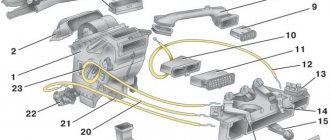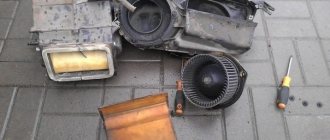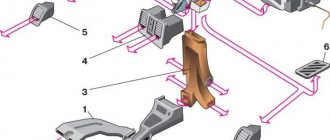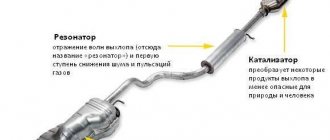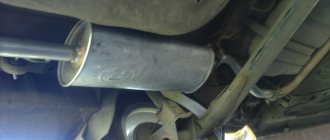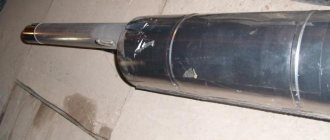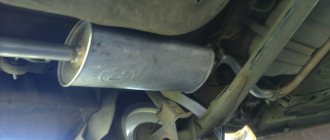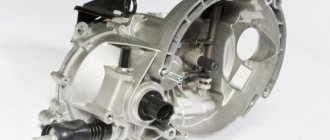Stove design
The principle of operation of the VAZ 2110 stove is carried out by supplying air with the help of a special fan through the heater radiator. Thus, the air passing through the radiator is heated and, in a heated state, enters the car interior. Also, the design of the “tens” heater provides the ability to regulate the air temperature and direction.
Some VAZ 2110 models were equipped with a recirculation valve, which opens and closes the air intake damper from the passenger compartment or from the street. This function allows you to move more comfortably in traffic jams or when driving behind trucks that release a lot of exhaust gases into the cabin.
Main elements of the heater:
- Radiator;
- Fan;
- flap;
- Control block;
- Gearmotor;
- Thermostat;
Checking the automatic control system
Diagram of the automatic heater control system : 1 – fan electric motor; 2 – additional resistor; 3 – controller; 4 – mounting block; 5 – ignition switch; 6 – cabin air temperature sensor; 7 – recirculation switch; 8 – recirculation valve; 9 – micromotor gearbox for heater damper drive; A – to the instrument lighting switch; B – to power supplies
SAUO pinout:
The SAUO receives information from:
- – cabin air temperature sensor (No. 6), which has a built-in small-sized fan.
- – MMR (micromotor reducer) (No. 9), information about the position of the heater damper.
Damper control : Based on the received information and the set air temperature, the controller controls the position of the heater damper, sending appropriate signals to the damper drive micromotor.
Fan speed control : to obtain a low rotation speed (all but the last), an additional resistor (No. 2) is used, which has two spirals with resistance (0.23 and 0.82 Ohms). When both spirals are connected to the electric motor power supply circuit, the 1st fan rotation speed is ensured; if a spiral with a resistance of 0.23 Ohm is turned on, the 2nd speed is provided. When the electric motor is turned on without a resistor, the fan rotor rotates at the maximum 3rd speed (4100 min-1).
Heater differences
In earlier versions of the VAZ 2110, the stove was a little simpler than at the end of its release. Initially, the direction of air flow was changed mechanically using a lever on the air ducts. In the latest modifications of the “tens” this system was changed, and now the direction of air flow was changed using a gearmotor.
It should be noted that the new model stove turned out to be much more efficient and warmer than its previous modifications.
New sample stove
Old style stove
Here you can notice differences in the heater control unit and in the air intake options. In subsequent models, the heater changed; the direction of air flow was controlled through the heater control unit.
Modification of damper and airflow
Many drivers may have encountered the problem that in very cold weather there is no way to regulate the uniform supply of warm air in all directions. So it turns out that either the side windows are covered with ice, or the legs freeze. For example, if the VAZ-21103 stove does not heat well, then the problem is obviously in the dampers. So, on vehicles that were produced after 2003, there is no such problem, but on those that came off the assembly line before, you will have to work with this. There is nothing complicated here; you will need to cut out the edges of the damper with a regular metal file (you don’t need to touch the windshield damper). You can also saw off a little bit from the flap that supplies air to the side windows. As a result, if you put the damper on the legs, then approximately 50% will go to the side windows, 25% to the legs, and another 25% to the windshield. If you install it on the windshield, it will blow only on it.
Another reason why the VAZ-21103 stove does not heat well is that the airflow is insufficient. Let's finalize it. For this you will need anthers, as well as a grille. Using an elastic band, we attach the grille to the boot, for which we use any suitable glue. We secure the boot on the reverse side with a clamp or tie and enjoy the result. This solution is not suitable for the driver’s seat, as it will heat up the right leg, but it’s perfect for passengers. Well, now let's move on, because we still have a lot to consider.
Why does the stove blow cold?
There are many reasons why the interior heater may not work effectively, so it is worth paying attention to each element of the interior heating system.
Let's look at the possible reasons.
Thermostat
The thermostat is one of the possible culprits of the problem. As you know, it is this that affects the temperature of the coolant, and if it malfunctions, the car simply will not be able to warm up to operating temperature, which will significantly reduce the efficiency of the heater. It is necessary to pay attention to the temperature readings on the dashboard; the arrow should be in the range of 80-90⁰С. If the temperature is significantly lower, the thermostat must be replaced.
Expansion tank cap
There is a special valve in the lid that prevents the formation of vacuum in the SOD. If this valve jams, a vacuum will form in the system, which will impede the circulation of liquid through the system and, therefore, reduce the efficiency of the VAZ 2110 stove.
Antifreeze level
If the stove blows cold, first of all you need to check the coolant level in the system. If it is below the minimum mark, it must be topped up. The level directly affects the operation of the stove, since if it is insufficient, an air lock may form in the radiator, which will lead to insufficient heating of the radiator itself.
Radiator clogged
When the radiator becomes clogged from the inside, the flow of fluid through it becomes worse, resulting in insufficient heating and, therefore, a decrease in its efficiency. You can check it by touching the pipes; they should be approximately the same temperature; if one of them is hot and the other is cold, the radiator is most likely clogged.
Gearmotor
In the “ten”, a damper is used to regulate the air temperature of the stove, which is driven by a special gearbox. It is this part that quite often fails, leaving the damper in the open position, which leads to air supply past the radiator.
Advice from experienced car owners
Eugene:
“I never thought I would encounter such a problem, but it happened. After repairing the cylinder head, it became very difficult to warm up the interior. I spent a long time searching for why, and it turned out that the engine was throttling. I did everything as advised, the coolant stopped bubbling only after 4 hours, but now it’s always warm in the cabin.”
Sanya:
“I have a VAZ 2109i, it blew cold at idle. I added coolant to the expansion tank, everything was ok.”
Rustam:
“I drive a 6th Mazda. Last winter, the heater began to act like a fool: over 2 tons of revolutions, hot air came out of it, over 3 tons, despite how much the temperature was set, the heater practically boiled with boiling water, but as soon as you stopped, the air became cool. I went through all the possible options described in the article, the problem did not go away, after a long search, the service station technicians found the reason - the climate control system had failed.”
We recommend: What to do if the wipers on a VAZ-2110 do not work: possible reasons
Ruslan:
“On my Priora, the stove also blew cold at idle, so to fix this I had to constantly add antifreeze. Got tired of it, sealed the lower pipe, now everything works properly.”
Oleg:
“As a service station worker, I can say that the warmest stove among all domestic cars is in Kalina, but sometimes it also malfunctions
As a rule, the whole problem lies either in the gasket of the pump, or in the pump itself, so if you are the owner of the named car, in which case the first thing you should pay attention to is the pump and its components.”
Heater fuse
As you know, to protect electrical circuits from short circuits or overloads, a special fuse is used, which in case of any problems blows and de-energizes the circuit.
This device protects the power supply circuit of the heater motor; if overloaded, this fuse blows, which completely disables the interior heater. To get the stove running again, you need to replace the fuse with a new one, but to do this you need to know where it is.
Where is
The heater fuse is located in the fuse block under number F18 and has a rated current of 25A. It is necessary to install only a fuse of the same rating to avoid damaging the circuit in the event of a short circuit or overload.
Operating modes
You can configure the heater operation manually or automatically. That is, you can set the temperature sensor according to your wishes, for example, at 22°C. If everything is in order, then the manufacturers promise that the deviations will be no more than 2°C, after which the relay will turn on the heating again, and after reaching the specified parameters, turn it off. But if failures occur, then after checking the functionality, it is quite possible that the sensor or relay will need to be replaced.
You can set the automatic mode. For this there is a special screw, the so-called tuning screw. It is advisable to make adjustments with the windows and doors closed. The fan handle should be in position “A”, and set the temperature at your discretion.
Take a test thermometer to the salon. If after 15 minutes the temperature does not correspond to the specified parameters, then you need to remove the controller from the socket and turn its adjustment screw. Clockwise to increase the temperature, counterclockwise to decrease it. If this does not help, then the sensor needs to be replaced.
SAUO block without panel
In addition, you may need to install a new control unit, or even tuning the entire heating system.
How does the VAZ 2110 interior temperature sensor work?
- Registration
- Entrance
- To the beginning of the forum
- Forum Rules
- Old design
- FAQ
- Search
- Users
. Said done, we disassemble the sensor, look, there is a thermistor approximately equal to 1200 ohms, a resistor of approximately 1500 ohms is connected in series with it, then a 30 ohm “tuning” resistor in series, then a jumper and EVERYTHING, then only the sensor terminals. We unsolder the jumper, solder in a 100 ohm resistor, put the sensor in place, check the operation of the system, etc. HERE IT IS, THE HARMFUL HAPPINESS OF THE TAZOVODA - the machine started working the way the designers intended. And in automatic mode it works as it should and in manual mode everything is tip top
okay, since you are so talented, tell me: why do I hear some squeaks and squeaks coming from this unit (well, where the temperature and speed of rotation of the fan are regulated) when I put it on heat? and why do I put it on the red dot - it’s hot, and just one point lower - it’s cold? By the way, on the side I have + - I didn’t see the manual adjustment, I have a block with the letter “A”.
I already had this. The variable resistor on the heater micromotor reducer is faulty. Not sold separately.. Replaced complete in 30 minutes. The SAUO unit does not understand what resistance is on the micromotor gearbox, i.e. what position is the damper in now (the tracks are worn out) and it’s going crazy. The flap moves back and forth. Price - 560 rubles. And what’s a shame is that the motor and gearbox are in good working order, but the resistor doesn’t cost a penny and it’s all a waste. Special respect to Vazu..
but I have a slightly different problem: 1. I put it on the red dot - it’s hot 2. I reduce it to 18 - it’s still hot 3. I remove it from the blue dot - it’s cold. 4. The cold continues until you turn to red again.
The variable resistor on the heater micromotor reducer is faulty. Not sold separately.. Replaced complete in 30 minutes.
Mouse 21113, tell me how you changed it, what did you take apart? Same crap!
How is this very resistor attached to the micromotor gearbox and is it really impossible to pick up anything from electronics stores (what kind of resistor is it, a non-standard one)?
voice
Article rating

